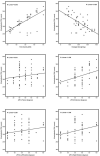Kinesiophobia and its correlations with pain, proprioception, and functional performance among individuals with chronic neck pain
- PMID: 34237105
- PMCID: PMC8266083
- DOI: 10.1371/journal.pone.0254262
Kinesiophobia and its correlations with pain, proprioception, and functional performance among individuals with chronic neck pain
Abstract
Chronic neck pain (CNP) incidence in the general population is high and contributes to a significant health problem. Kinesiophobia (fear of pain to movement or re-injury) combined with emotions and physical variables may play a vital role in assessing and managing individuals with CNP. The study's objectives are 1) to evaluate the relationship between kinesiophobia, neck pain intensity, proprioception, and functional performance; 2) to determine if kinesiophobia predicts pain intensity, proprioception, and functional performance among CNP individuals. Sixty-four participants with CNP (mean age 54.31 ± 9.41) were recruited for this cross-sectional study. The following outcome measures were evaluated: Kinesiophobia using the Tampa Scale of Kinesiophobia (TSK), neck pain intensity using the visual analog scale (VAS), cervical proprioceptive joint position errors (in flexion, extension, and rotation directions) using cervical range of motion (CROM) device and handgrip strength as a measure of functional performance using the Baseline® hydraulic hand dynamometer. Kinesiophobia showed a strong positive correlation with neck pain intensity (r = 0.81, p<0.001), a mild to a moderate positive correlation with proprioception joint position errors (JPE) in extension, rotation left and right directions (p<0.05), but no correlation in flexion direction (p = 0.127). Also, there was a moderate negative correlation with handgrip strength (r = -0.65, p<0.001). Regression analysis proved that kinesiophobia was a significant predictor of pain intensity, proprioception, and functional performance (p<0.05). This study infers that kinesiophobia in individuals with CNP predicts pain, proprioception, and functional performance. Kinesiophobia assessment should be considered in regular clinical practice to understand the barriers that can influence rehabilitation outcomes in CNP individuals.
Conflict of interest statement
No authors have competing interests.
Figures



References
-
- Carvalho RCd, Maglioni CB, Machado GB, Araújo JEd, Silva JRTd, Silva MLd. Prevalence and characteristics of chronic pain in Brazil: a national internet-based survey study. BrJP. 2018;1(4):331–8.
Publication types
MeSH terms
LinkOut - more resources
Full Text Sources
Medical

